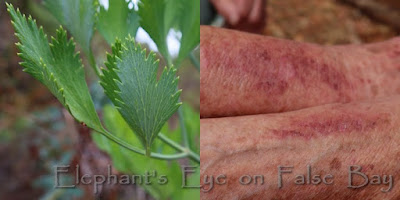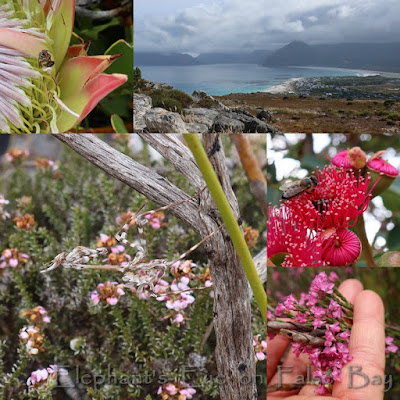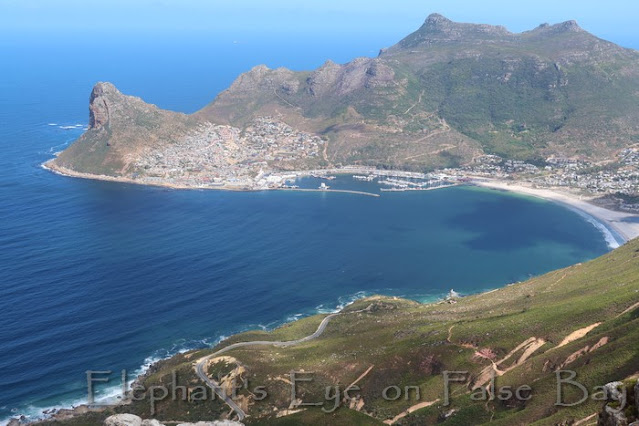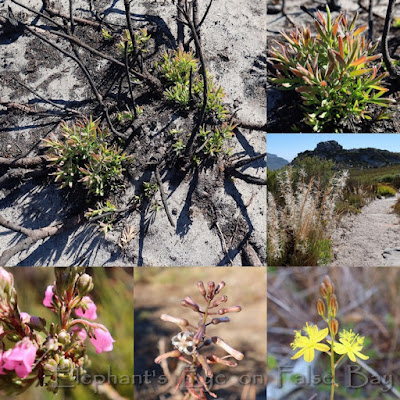February hikes to Cecilia Forest, Slangkop, to Blackburn Ravine and Elsie's Peak
by Diana Studer
- gardening for biodiversity
in Cape Town, South Africa
Hiking among wildflowers
in the mountains
around Cape Town
February is Disa month. Started from Cecilia Forest to avoid gate fee at Kirstenbosch. Botanical Society members have lost their free entry - we need a new SANBI card. More disas blooming than we have seen before. Almost 20, and a bud. One ripped trouser to reach that Hex of Hex River - we met an Afrikaans teacher who told us the story. Disa uniflora - Pride of Table Mountain - likes damp cliffs or stream banks.
 |
| Disa uniflora Kirstenbosch in February |
Blissful in forest with stream running - Disney and Bambi. Twinkly sparkly feather moss is Neckera valentiniana for Valentine's Day! Big fruit polypody fern. Long walk across to our kloof. Hot and exposed in former bluegum and pine plantation with black girdled lizard. Helichrysum grandiflorum ivory and silver against bronzed fallen eucalyptus leaves. Pink is unusual for our Crassula coccinea. Finally reached the natural fynbos above Kirstenbosch.
 |
| Cecilia to Kirstenbosch Flowers in February |
They call it blister bush. Does it? Leaves like celery, but beware. 2 guinea-pigs volunteered (not me, not a chance!) They mashed the leaves, rubbed them on 2 arms. Hiked in the sun for the morning - since it needs sunshine to react. With token picture of relevant leaves, not the actual guilty plant. Results after 2 weeks. Still red and angry, and yes there were actual blisters.
 |
| Blister bush |
Only 5 cellophane bees observed on iNaturalist for the Cape Peninsula. Looking down to Kommetjie. Conehead mantis nymph pretending to be a spider against grey wood. Avenue, past the church where we park, is planted with flowering gums. Slangkop for Erica ferrea - tubby with a collar (but Erica corifolia pictured). Burnt on Christmas Eve just over a year ago. We walked 7 km.
 |
| Slangkop biodiversity in February |
Up to radar station to decipher new graffiti. Two spotted frogs nose to nose? Aboriginal dreamtime art in dots.
 |
| Dotted frogs on Slangkop |
Silvermine to Blackburn Ravine for That View to Hout Bay. DOWN Blackburn Ravine and across. We need only walk along, not much uphill.
 |
| Our view from the top of Blackburn Ravine |
Lots of black girdled lizards and agamas - also 2 babies who were camera shy!
 |
| Baby agamas |
Blue Disa graminifolia. Red Disa ferruginea cheats - NO nectar for pollinators (while red Tritoniopsis triticea has nectar for endemic Table Mountain Pride Butterfly). Another flaming red day. F's caterpillar 'unequal shark' - very pretty with dots and stripes in bright colours. Erica nevillei likes rocks and endures nectar thieves. Erica nevillei was Neville Pillans' 4124th contribution to the Bolus herbarium! Curly grass. Stoebe capitata. A longer walk, grateful for some clouds, even a few spots of rain. But a light breeze with a gentle hint of autumn.
 |
| Silvermine to Blackburn February flowers |
To see the Haemanthus sanguineus (UNspotted stalk) near Elsie's Peak after the Brakkloofrant fire 22 December.
 |
| Haemanthus sanguineus February on Elsie's Peak after fire |
Leucadendron salignum resprouting with many stems. Spiky blonde grass. Sticky Erica viscaria. White Drimia media. Bulbine favosa - fluffy anthers and no leaves now. We will not forget that cautious walk down again!
 |
| Elsie's Peak in February Flowers after December fire |
My hikes are listed on my page.
I invite you to join us at Elephant's Eye on False Bay. Please subscribe as you prefer
via Feedly,
or my Facebook blog page
Pictures by Diana Studer
of Elephant's Eye on False Bay
Teal blue text is my links.
To read comments if you are in a Reader,
first click thru to the blog)
Thanks for comments that add value. Your comment will not appear until I've read it. I welcome comments on posts from the last 2 months.
Google and Blogger comments uncooperative? Use Name / URL instead.

Your hike posts never disappoint, Diana, reaffirming your cape's reputation for nearly miraculous biodiversity. That Haemanthus sanguineus is amazing, especially the shot showing the bloom without a a visible stem.
ReplyDeleteWonderful!
ReplyDeleteI'm not familiar with Disas. I'll have to look them up and read more about them. They, and the other plants you've shared here, are wonderful. Thanks for taking us along on your hikes.
ReplyDeleteDiana, you live in such a beautiful part of the world! I'd love to explore more of the Cape but Le Husband isn't a fan of hiking.
ReplyDeleteWe have stinging nettles alongside the paths I used to run and I was always getting scratched by them. I'd get a single, long scratch that would bleed and go angry and red and welt for weeks. Suffice to say, I'd never willingly rub a blister plant on myself!!
Whoever was curious enough to try the Blister bush--yikes! I'm sure their curiosity is now completely satisfied?? Looks very painful. Otherwise, what a marvelous adventure through amazing biodiversity. Thanks for taking us along.
ReplyDeleteBoth arms looked okay yesterday. More nuisance than pain, from what they told us.
DeleteWhat a fabulous view. I so enjoy coming along on your hikes. Those Risa remind me a bit of our trillium. And the Haemanthus sanguineus blooming against the black char from the fire is amazing. Gorgeous.
ReplyDelete